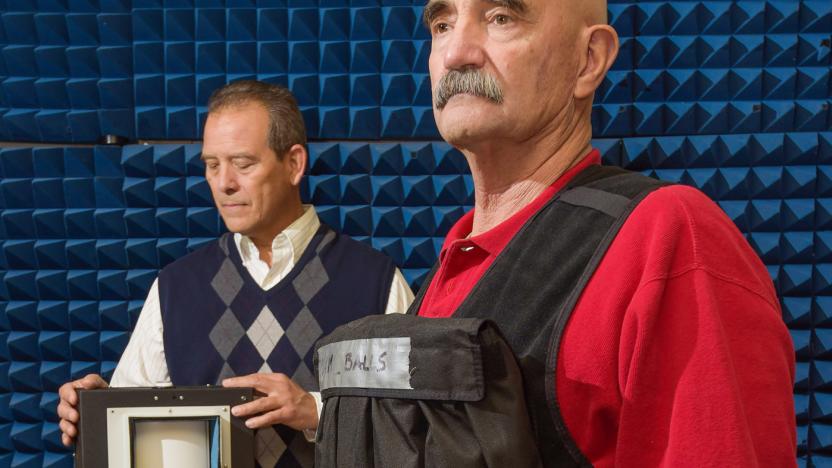bombdetector
Latest

Terahertz laser tech could scan for bombs at airports
Terahertz spectrum scanning is potentially ideal for finding bombs due to the sheer range of materials it can detect, but it's not exactly practical for luggage checks when you need both a suitcase-sized machine and up to half an hour to conduct a scan. MIT researchers have a better way, though: they've developed a quantum cascade laser system that should make terahertz detection a reality. Since the laser's single, tiny frequency comb only consumes power for very brief periods, you can fit it into a part the size of a chip without a gigantic cooling unit -- perfect for airport scanners. It takes as few as 100 microseconds to identify a substance, too, so you wouldn't have to wait (longer than usual, anyway) while agents scan your bags.

A real suicide bomb detector should arrive this year
Ever since terrorism became an all-too-real fact of life, people have dreamed of suicide bomb detectors that spot an explosive vest before its wearer has a chance to detonate. However, making a working example has proven elusive. Some companies threw their hands up in frustration after developing systems that just weren't accurate enough. Others, meanwhile, didn't even try that hard -- the UK went so far as to ban some detectors that proved utterly ineffective. At last, though, it looks like a genuinely functional suicide bomb detector is on the horizon.

Optical nanotech sensor can sniff out bad food and explosives
The days of having to rely on pricey lab sensors (or carefully trained canines) to detect bad food and bombs may soon come to an end. Oregon State University researchers have developed a hybrid optical and nanotechnology sensor that's at once super-sensitive to gas, but won't weigh a ton or cost a fortune. It uses a super-thin, metal-organic film to absorb the gas, and magnifies the telltale chemical signals using low-cost plasmonic nanocrystals that act like miniature optical lenses. It's best-suited to watching out for carbon dioxide (helpful for businesses that want to fight greenhouse gases), but it can detect a "wide range" of materials.

Super-sensitive chip can sniff out bombs from 16 feet away
Let's face it: the theatrical security procedures at airports aren't going away any time soon. However, they might just get more tolerable if a team of Israeli researchers bring a new, extremely sensitive bomb detection chip to an inspection line near you. The prototype sniffs for explosives by using groups of nano-scale transistors that react to tiny electrical changes when certain chemicals pass by. And we do mean tiny -- the chip can raise alarms if there are just a few molecules found out of 1,000 trillion. For those not keeping score, previous techniques will 'only' raise a red flag in the molecules per billion range.

Researchers use inkjet acumen to create wireless explosive sensor from paper
Meet Krishna Naishadham and Xiaojuan (Judy) Song. They're researchers at the Georgia Institute of Technology, and those little devices they're holding may one day save you from an explosive device. This petite prototype is actually a paper-like wireless sensor that was printed using basic inkjet technology, developed by professor Manos Tentzeris. Its integrated lightweight antenna allows the sensor to link up with communication devices, while its functionalized carbon nanotubes enable it to pick up on even the slightest traces of ammonia -- an ingredient common to most IEDs. According to Tentzeris, the trick to such inkjet printing lies in the development of "inks" that can be deposited at relatively low temperatures. These inks, laced with silver nanoparticles, can then be uniformly distributed across paper-based components using a process called sonication. The result is a low-cost component that can adhere to just about any surface. The wireless sensor, meanwhile, requires comparatively low amounts of power, and could allow users to detect bombs from a safe distance. Naishadham says his team's device is geared toward military officials, humanitarian workers or any other bomb sniffers in hazardous situations, though there's no word yet on when it could enter the market. To find out more, careen past the break for the full PR.

Sprint radar imaging system peeps inside walls, floors to detect bombs, tell-tale hearts
Back in 2005, we reported on a little something called the Prism 200, which allowed its holder to essentially see what folks were doing on the other side of a wall. Since then, we've seen plenty of devices that boast the same claims, but it wasn't until recently that the makers of the Prism 200 created a device that can actually see inside those walls. Looking something akin to an old school punch clock, Cambridge Consultants' Sprint in-wall radar imaging system provides 3D renderings of items embedded in walls, floors, and even ceilings. Where as existing X-ray systems require access to both sides of a wall, Sprint's radar setup allows users to see what's going on inside without dual access. As you might imagine, Cambridge is pushing this thing as a security tool, allowing for detection of bombs, drugs, dead bodies -- you know, the usual bad guy stuff. Sprint is currently undergoing testing. Full PR after the break.

Scientists stumble upon bomb-sniffing laser with a boomerang effect
You might think of a laser as light forced into a single, directed beam, but scientists have recently discovered that if you fire a laser in one direction, the air itself can fire another right back. Using a 226nm UV laser, researchers at Princeton University managed to excite oxygen atoms to the point that they emit infrared light along the same channel as the original beam, except this time pointed back where it came from. Since the return beam's chemistry depends on the particles in the air to generate the return beam, the "backward laser" could potentially carry the signature of those particles back to the source and help identify them there. That seems to be the entire goal, in fact -- the project, funded by an Office of Naval Research program on "Sciences Addressing Asymmetric Explosive Threats," hopes that such a laser can ID bombs from a distance by hunting for trace chemicals in the air. Sounds like the perfect addition to our terahertz specs, and one step closer to the tricorder of our dreams.

Modified radar gun identifies suicide bombers up to ten meters away
William Fox of the Naval Postgraduate School in Monterey and John Vesecky, his colleague at UC Santa Cruz, are working on a modified radar gun that can identify suicide bombs worn under the clothing. To do this, they cataloged the most common arrangements of looped wires used to construct "suicide vests," and developed software that can identify the radar cross-section of each. So far, results have been pretty good: according to New Scientist, "telltale factors in the polarisation of the reflected signals" allowed them to correctly identify volunteers dressed as bombers up to ten meters away, roughly eighty-five percent of the time. Of course, even with a success rate this high, such a system would be prone to kicking up false positives. In order to minimize this, the devices would have to combined with other technologies, such as smart surveillance camera systems and infrared imaging.


